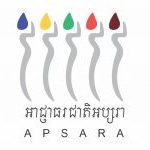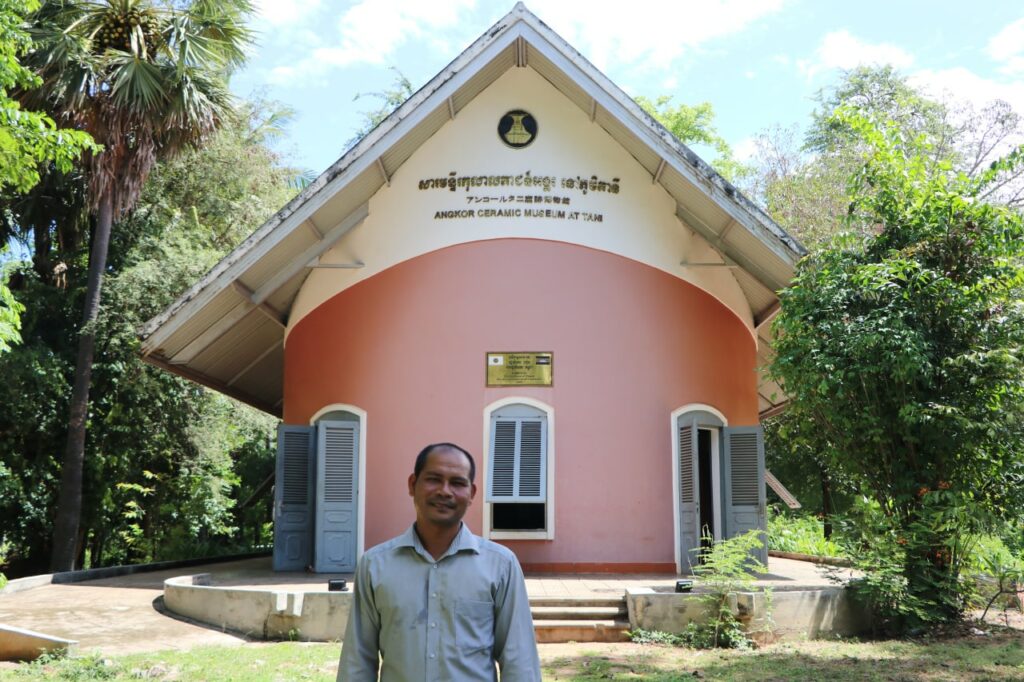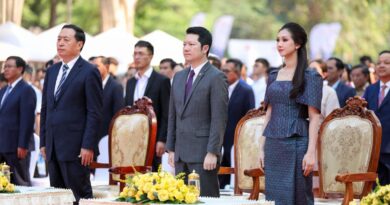សារមន្ទីរកុលាលភាជន៍អង្គរភូមិតានី មានទីតាំងស្ថិតនៅភូមិតានី ឃុំរុនតាឯក ស្រុកបន្ទាយស្រី ខេត្ដសៀមរាប ចម្ងាយប្រមាណ៣២គីឡូម៉ែត្រ ភាគឦសានក្រុងសៀមរាប។ សារមន្ទីរកុលាលភាជន៍អង្គរភូមិតានី ជាសារមន្ទីរដំបូងនៅកម្ពុជា ដែលបានសាងសង់ឡើងនៅលើទីតាំងស្ថានីយបុរាណវិទ្យាផ្ទាល់។ នាកំឡុងសតវត្សទី១០-១១ ក្នុងសម័យអង្គរ ទីនេះជាទីតាំងឧស្សហកម្មផលិតកុលាលភាជន៍ខ្មែរ សម្រាប់បម្រើឱ្យជីវភាពរស់នៅរបស់បុព្វបុរសខ្មែរ។ សំណល់ទួលបុរាណ បំណែកកុលាលភាជន៍រាប់លានបំណែក គ្របដណ្ដប់នៅលើផ្ទៃទំនប់ដែលមានប្រវែងប្រហែល៩០០ម៉ែត្រ មានសារសំខាន់ណាស់ក្នុងការស្រាវជ្រាវវិស័យកុលាលភាជន៍ខ្មែរ ដែលវិស័យនេះទើបមានការចាប់អារម្មណ៍ពីសំណាក់អ្នកស្រាវជ្រាវ ក្រោយស្រុកទេសយើងមានសុខសន្ដិភាពបរិបូរណ៌មកនេះ ដែលមុនសម័យសង្រ្គាម មានការសិក្សាតិចតួចនៅឡើយ។ ដោយយល់ថាបណ្ដុំឡបុរាណភូមិតានី មានសារសំខាន់លើសិក្សាស្រាវជ្រាវវិស័យកុលាលភាជន៍ខ្មែរ អាជ្ញាធរជាតិអប្សរា បានកំណត់ព្រំតំបន់ការពារឡបុរាណសម័យអង្គរ ក្នុងទំហំផ្ទៃដី៣៤ហិកតា គ្របដណ្ដប់លើទំនប់បុរាណប្រវែង៩០០ម៉ែត្រ ដែលមានក្រុមឡចំនួន៥ក្រុម(ក្រុមក ខ គ ឃ ង)ក្នុងនោះមាន២៧ទួលឡបុរាណ និងត្រពាំងបុរាណតូចធំជាច្រើន ដែលអ្នកស្រាវជ្រាវសន្មតថាជារណ្ដៅដីឥដ្ឋ សម្រាប់ផ្គត់ផ្គង់សង្វាក់ផលិតកម្មកុលាលភាជន៍ នៅឡតានីផ្ទាល់។
សារមន្ទីរនេះ គឺជាមជ្ឈមណ្ឌលតាំងបង្ហាញកុលាលភាជន៍ច្រើនប្រភេទ ដែលអ្នកស្រាវជ្រាវផ្នែកបុរាណវិទ្យារកឃើញពីរណ្ដៅកំណាយបុរាណវិទ្យា ពីបណ្ដុំឡបុរាណនានាជុំវិញ និងក្នុងតំបន់អង្គរ។ ក្នុងនោះមានដូចជាស្ថានីយឡបុរាណអន្លង់ធំ ខ្នារពោធិ៍ សរសី បង្កោង រួមទាំងឡតានីផ្ទាល់ មកដាក់តាំងបង្ហាញនៅសារមន្ទីរនេះ។
លោក វង្ស សាវុទ្ធី បុគ្គលិកបច្ចេកទេសសារមន្ទីរកុលាលភាជន៍អង្គរភូមិតានី នាយកដ្ឋានអភិវឌ្ឍន៍វប្បធម៌និងបទដ្ឋានបេតិកភណ្ឌ នៃអាជ្ញាធរជាតិអប្សរា ឱ្យដឹងថាកុលាលភាជន៍ទាំងអស់នេះ ប្រាប់ឱ្យយើងដឹងបន្ថែមពីជីវភាព របៀបរបបរស់នៅប្រចាំថ្ងៃ ពាណិជ្ជកម្ម និងការវិវឌ្ឍនៃសិប្បកម្មកុលាលភាជន៍របស់បុព្វបុរសខ្មែរសម័យអង្គរ។ លោកបន្ដថា ក្រៅពីប្រាសាទដ៏មហិមា ហេដ្ឋារចនាសម្ពន្ធ បារាយដែលជាភស្ដុតាងនៃអារ្យធម៌អង្គរ កុលាលភាជន៍ ក៏ជាផ្នែកមួយនៃភាពសម្បូររុងរឿងរបស់បុព្វការីយើងដែលកូនខ្មែរគ្រប់រូបពុំគួរមើលរំលងឡើយ។ ដូចយើងបានជ្រាបហើយថា ព័ត៌មានពីសិលាចារឹករៀបរាប់អំពីព្រឹត្ដិការណ៍ផ្សេងៗនៃព្រះមហាក្សត្រ ព្រះរាជគ្រូ បុរោហិត អភិជន គ្រឿងដង្វាយជាខ្ញុំបម្រើ និងភស្ដុភារផ្សេងៗចំពោះប្រាសាទ ពុំផ្ដោតសំខាន់លើជីវភាពប្រចាំថ្ងៃទេ ក្រៅតែអំពីចម្លាក់លិបនៅថែវប្រាសាទបាយ័ន្តនោះ។ ការសិក្សាស្វែងយល់អំពីកុលាលភាជន៍ អាចឱ្យយើងស្វែងយល់បន្ថែមអំពីសង្គមមនុស្សសម័យបុរាណ បន្ថែមលើចម្លាក់លិបនៃប្រាសាទបាយ័ន្ត។
លោក វង្ស សាវុទ្ធី បានអំពាវនាវ និងលើកទឹកចិត្តឱ្យភ្ញៀវទេសចរណ៍ជាតិ និងអន្ដរជាតិ ងាកទៅរកសារមន្ទីរផ្សេងៗទៀតក្នុងតំបន់សៀមរាប ជាពិសេសសារមន្ទីរកុលាលភាជន៍អង្គរភូមិតានី ដើម្បីទទួលបានចំណេះដឹងអំពីវិស័យកុលាលភាជន៍ខ្មែរដែលមានតាំងបង្ហាញក្នុងសាលពិព័រណ៌សារមន្ទីរ ហើយក្រៅពីសមុច្ច័យដែលតាំងបង្ហាញភ្ញៀវទេសចរអាចដើរទស្សនាបណ្ដុំឡបុរាណទាំង៥ក្រុម ទេសភាពវាលស្រែ ព្រៃឈើ និងជីវភាពប្រជាពលរដ្ឋ ក្នុងតំបន់ការពារឡបុរាណភូមិតានីបាន។
លោក វង្ស សាវុទ្ធី បានបន្ថែម ដោយហេតុថាបច្ចុប្បន្ននេះតំបន់សៀមរាប-អង្គរ ជាតំបន់ដែលមានជំរើសទេសចរណ៍ច្រើន ហើយភ្ញៀវទេសចរគ្រប់រូប គឺសំដៅតែតំបន់ប្រាសាទបុរាណសំខាន់ៗក្នុងរាជធានីអង្គរ ដែលធ្វើឱ្យប្រាសាទសំខាន់ៗខ្លះមានភ្ញៀវទេសចរច្រើនកកកុញ ដែលអាចរងផលប៉ះពាល់តិច ឬច្រើនចំពោះប្រាសាទ។ ភ្ញៀវទេសចរ គួរងាកមកចាប់អារម្មណ៍លើវិស័យផ្សេងៗនៃអារ្យធម៌អង្គរ ព្រោះអារ្យធម៌អង្គរ ពុំមែនមានតែប្រាង្គប្រាសាទ ឬបារាយនោះទេ តែយើងគួរសិក្សាស្វែងយល់បន្ថែមលើវិស័យផ្សេងទៀត ដែលទ្រទ្រង់ឱ្យអារ្យធម៌អង្គររីកចម្រើនថ្កុំថ្កើងឡើង ឧទាហរណ៍វិស័យកុលាលភាជន៍នេះជាដើម៕
អត្ថបទ និងរូបភាព៖ លោក យី សុថា
Angkor Ceramic Museum at Tani Village, Khmer Ceramic Industrial Site in Angkorian Period
Angkor Ceramic Museum is located in Tani village, Run Ta Ek Commune, Banteay Srei District, Siem Reap Province, approximately 32 km northeast of Siem Reap City. This ceramic museum is the first museum in Cambodia to be built on an archeological site. During the 10th-11th centuries during the Angkorian period, this was an industrial site for the production of Khmer ceramics for the livelihood of the Khmer ancestors. Ancient mounds and millions of ceramic pieces covering the surface, which is about 900 meters long, are very important in the research of the Khmer ceramic sector, which has just attracted the interest of the researchers. Recognizing the importance of the Tani ancient kiln collection in the study of Khmer ceramics, the APSARA National Authority has demarcated a 34-hectare Protected Area covering a 900-meter-long ancient site with five groups of kilns. There are 27 ancient mounds and many small and large ancient ponds, which researchers believe are clay pits to supply the ceramic production in this ancient kiln site.
The museum is a center for exhibiting a wide variety of ceramics, which archaeologists have discovered from archeological excavations from archeological sites and around the Angkor site such as Anlong Thom kiln station, Khnar Po, Sar Sei, Bangkong, as well as the Tani itself on display at this museum.
Mr. Vong Savuthy, Technical Officer of Angkor Ceramic Museum from the Department of Cultural Development, Museums, and Heritage Norms of APSARA National Authority, said that all these ceramics tell us more about daily life, trade, and development of handicrafts, ceramic of Khmer ancestors during the Angkorian period. He continued that in addition to the great temple, and the infrastructure of the Baray, which is a testament to the Angkorian civilization, the ceramic product is also a part of the prosperity of our ancestors, which should not be overlooked by all Cambodian people. As we all know, inscriptions depicting the events of kings, priests, nobles, offerings, slaves, and logistics for temples do not focus on everyday life but only on the carvings in the gallery at Bayon temple. Studying ceramics allows us to learn more about ancient society in addition to the carvings of the Bayon temple.
Mr. Vong Savuthy appealed to and encouraged national and international tourists to visit other museums in the Siem Reap area, especially the Angkor Ceramic Museum to gain knowledge about the Khmer ceramic industry on display in the museum gallery. Visitors can visit the five groups of ancient kilns, landscapes, fields, forests, and the lives of people in the ancient kiln protection area of Tani village.
Mr. Vong Savuthy added that currently, the Siem Reap-Angkor area is an area with a lot of tourist options and all tourists refer only to the main ancient temples in Angkor, which makes some important temples have a lot of tourists may affect more or less the temple. Tourists should turn their attention to various fields of Angkorian civilization because Angkorian civilization is not only about temples or barays, but we should learn more about other areas that support the growth of Angkorian civilization, for example, the ceramic sector.
Article and Photos: Yi Sotha





